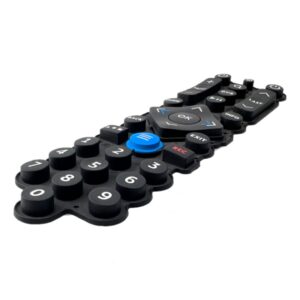Overview
Silicone Rubber Keypads are integral components in numerous electronic devices, such as remote controls, keypads, and mobile phones. Renowned for their durability, flexibility, and resistance to extreme temperatures, these keypads can benefit significantly from various coatings that enhance their functionality and lifespan. This article explores different coating options for Silicone Rubber Keypads.

![]()
![]()
Coating Options for Silicone Rubber Keypads
Acrylic Coatings
Characteristics
Acrylic coatings consist of acrylic resins and solvents, known for their excellent resistance to weathering, UV light, and chemicals. Available in a wide range of colors, they can be tailored to specific needs.
Benefits
Acrylic coatings are ideal for applications requiring high weatherability and color stability. They provide a hard, glossy finish that is easy to clean and maintain. These coatings are also cost-effective and straightforward to apply.
Applications
Commonly used in keypads for outdoor equipment, signage, and marine applications, acrylic coatings are also found in consumer electronic devices, automotive keypads, and household appliances.
Disadvantages
Acrylic coatings may lack the durability of other coatings, with lower chemical resistance and adhesion, potentially impacting their longevity and effectiveness.
Polyurethane Coatings
Characteristics
Polyurethane coatings are composed of polyols and isocyanates, known for their excellent abrasion resistance, flexibility, and adhesion. Available in numerous colors, they can be customized to meet specific requirements.
Benefits
Ideal for applications requiring high flexibility and impact resistance, polyurethane coatings can withstand bending and stretching without cracking or peeling. They provide a soft, comfortable tactile feel, perfect for consumer electronic devices.
Applications
These coatings are commonly used in keypads for mobile phones, remote controls, and gaming consoles, as well as automotive keypads, medical devices, and household appliances.
Disadvantages
Polyurethane coatings are sensitive to UV light and may yellow over time. Additionally, achieving an even application can be challenging, affecting the appearance and functionality of the keypad.
Epoxy Coatings
Characteristics
Epoxy coatings, made from a mix of epoxide resins and hardeners, are known for their excellent adhesion, durability, and resistance to corrosion and chemicals. They are available in various colors and can be customized.
Benefits
Epoxy coatings are ideal for high-strength applications, capable of withstanding extreme temperatures, chemicals, and abrasion. They offer a smooth, glossy finish that is easy to clean and maintain.
Applications
These coatings are frequently used in keypads for medical devices, military equipment, and industrial machinery, as well as electronic devices in harsh environments like oil rigs, mines, and underwater equipment.
Disadvantages
Epoxy coatings can be costly and require specialized skills and equipment for application. Their low flexibility might affect the tactile feel of the keypad.
Siloxane Coatings
Characteristics
Siloxane coatings, composed of silicone resins and solvents, are known for their excellent resistance to water, chemicals, and UV light. These coatings are available in various colors and can be customized.
Benefits
Ideal for environments requiring resistance to water, chemicals, and UV light, siloxane coatings provide enhanced durability and protection.
Disadvantages
Siloxane coatings tend to be more expensive and offer a limited range of colors. Careful application is necessary to avoid visible brush marks or bubbles.
Choosing the Right Coating
When selecting a coating for a Silicone Rubber Keypad, several factors should be considered:
Functionality
The coating should improve grip, tactility, and ease of use while meeting the device’s requirements for waterproofing, chemical resistance, and UV protection.
Durability
The coating must withstand the intended use and environmental conditions, resisting wear and tear while maintaining its appearance and functionality over time.
Environment
The coating should be suitable for the device’s environment, whether indoor or outdoor, and resist fading, discoloration, and other forms of degradation.
Cost
The coating should be cost-effective, balancing performance, durability, and appearance within the device’s budget.
Conclusion
In conclusion, the choice of coating for Silicone Rubber Keypads significantly impacts their functionality, durability, and appearance. Epoxy, polyurethane, siloxane, and acrylic coatings each offer distinct advantages and drawbacks. Selecting the best coating involves considering factors such as functionality, durability, environment, and cost to achieve the optimal balance for the specific application.
In addition to coating options, you can also choose the color, size and hardness of silicone rubber keypad. If you have any specific needs, you can communicate with our designers and we will try our best to meet your requirements.